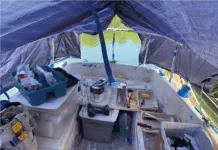I didn’t mean to buy an old wooden boat. At age 24, the 53-year-old Atkin ketch was what I could afford. But there was something else about Tosca that drew me in. The bulkheads groaned, the mast creaked, and in even in a tranquil cove, the barn-door rudder gently swung, as if she couldn’t sit still. Made mostly of oak, cedar, spruce and teak, the old gaffer was alive.
Thirty years later, I intentionally sought a fiberglass boat, eventually settling on a Yankee 30 named Opal, a Sparkman and Stephens sloop built in 1971. With a little more money at hand and fewer years left to sail, one’s priorities begin to shift. I’m determined to spend more of my time sailing, even if it involves compromises.
Of course, a plastic boat—no matter the pedigree—is no guarantee of more time on the water. Plenty of wooden boats in Maine see more sailing days than their plastic slip neighbors. But my own cruising grounds—the warm, wet coastal islands, bays, and estuaries of South Florida—eats wooden boats for breakfast. And according to Drew Frye’s report on plastic boat bits (see page 4), Florida can be just as merciless on plastic.
While Opal’s recently painted hull, deck, spars, and rigging show very few signs of age, nearly everything else is weathered. The plastic parts are suffering the most. Canvas zippers have turned to powder, plastic sheaves are cracked, rope clutch handles are faded and rough with oxidation. But the plastic jaws on Opal’s self-tailing winches, installed at the same time as the clutches and made of the same material, look almost new. This is because the winches are covered in port while the clutches are left to bake in the sun.
We all know the harm UV can do, but the chief instigator in most plastic failures is not UV radiation. Nor are the chemicals in the rain, dock water, or boat cleaners fully to blame. Human judgement is the main problem. Simply put, manufacturers and consumers alike expect more from molded polymers than they can deliver.
There is a mind-boggling variety of plastics, and many are well-suited for marine applications. Many more are not. Most recently, a “marine-grade” 12-volt outlet that we had initially admired began cracking due to UV exposure after just three months on our test boat.
Even the most respected names in sailing gear can do a better job publicizing the limits of their products. Prominent cautions against overtightening screws in plastic threads, and statements on expected life spans would be welcome steps. And makers need to stop using plastic where it doesn’t belong—in cleats, for example.
Manufacturers are not miracle workers, nor can they anticipate all the creative ways sailors break stuff. If we want to keep plastics out of the waste stream, sailors need to do a better job of educating ourselves. Plastic boat gear like floating winch handles have made our lives easier, but to depend on these products without making an effort to understand their limits requires a risky roll of the dice.
Plastic is truly fantastic—when tempered with fair expectations.



































